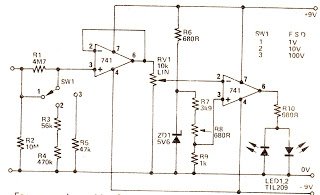This simple LED voltmeter circuit, although simple, is capable of accurate voltage measurement.
The input is applied to the high impedance input of IC1 via the attenuator comprising of R1 to R5 inclusive.
How the Circuit Works
Since this IC is used as a unity gain buffer, the output at pin 6 is equal to the input voltage at pin 3, but at a low impedance.
IC2 is connected as a comparator driving a pair of LEDs, D1 and D2.
The inverting input samples a portion of the unknown input voltage, whilst the non—inverting input is connected to a 1V reference obtained from the stable voltage across ZD1.
In use RV1 is adjusted till D2 just illuminates.
At this point, if the control knob is of the 0 - 10 calibrated type, the pointer will indicate the input voltage. For example, with SW1 in position 2, and with a reading of 2 on RV1, the input voltage will be 2V.
With a little practice, the voltage can be read to 1-2%, comparable to a moving coll instrument. The input lmpedance on all ranges is 3.2M.
The proposed simple LED voltmeter circuit shows how an LM39OON amplifier may be employed to compare two input voltages and to indicate the result by means of a small lamp.
If the input voltage connected to the non- inverting input is appreciably more positive than the other input, the output of the amplifier will provide a positive voltage which renders the TR2 conducting. The lamp will then be illuminated.
One of the inputs may be a reference voltage so that one can then compare a single input voltage against this constant reference.

Leave a Reply